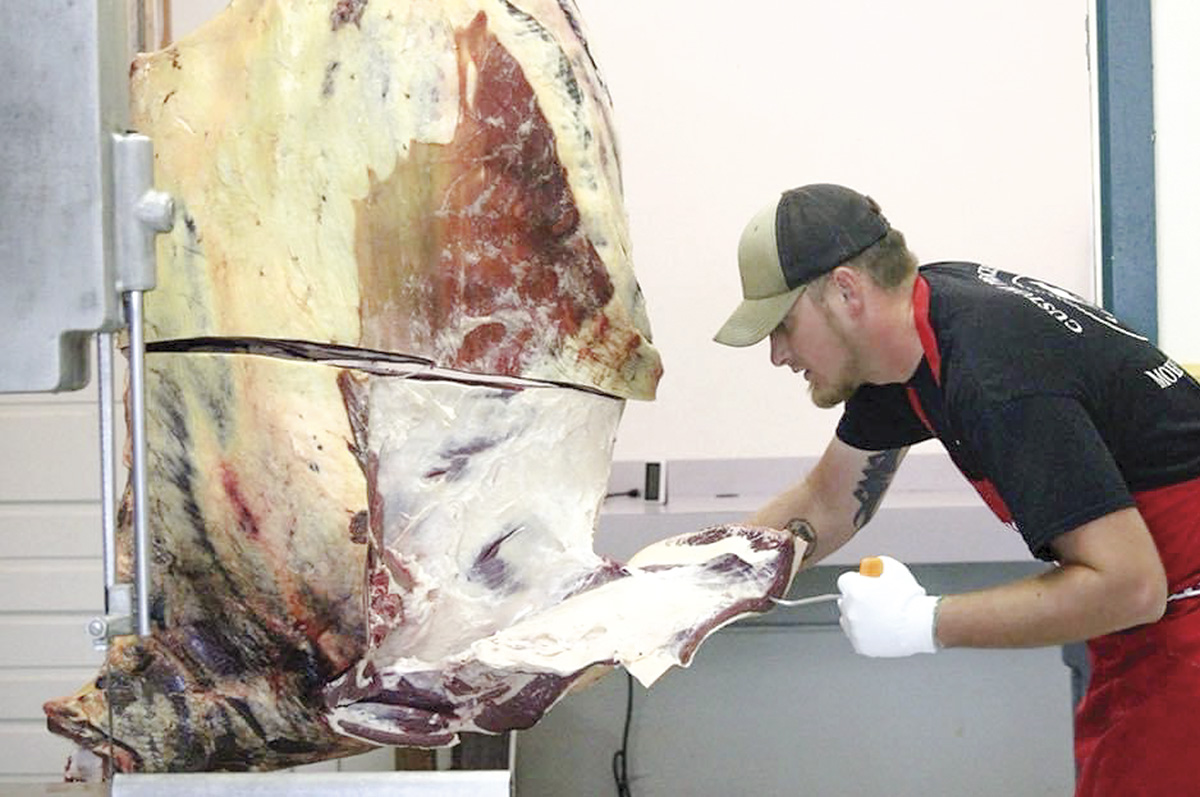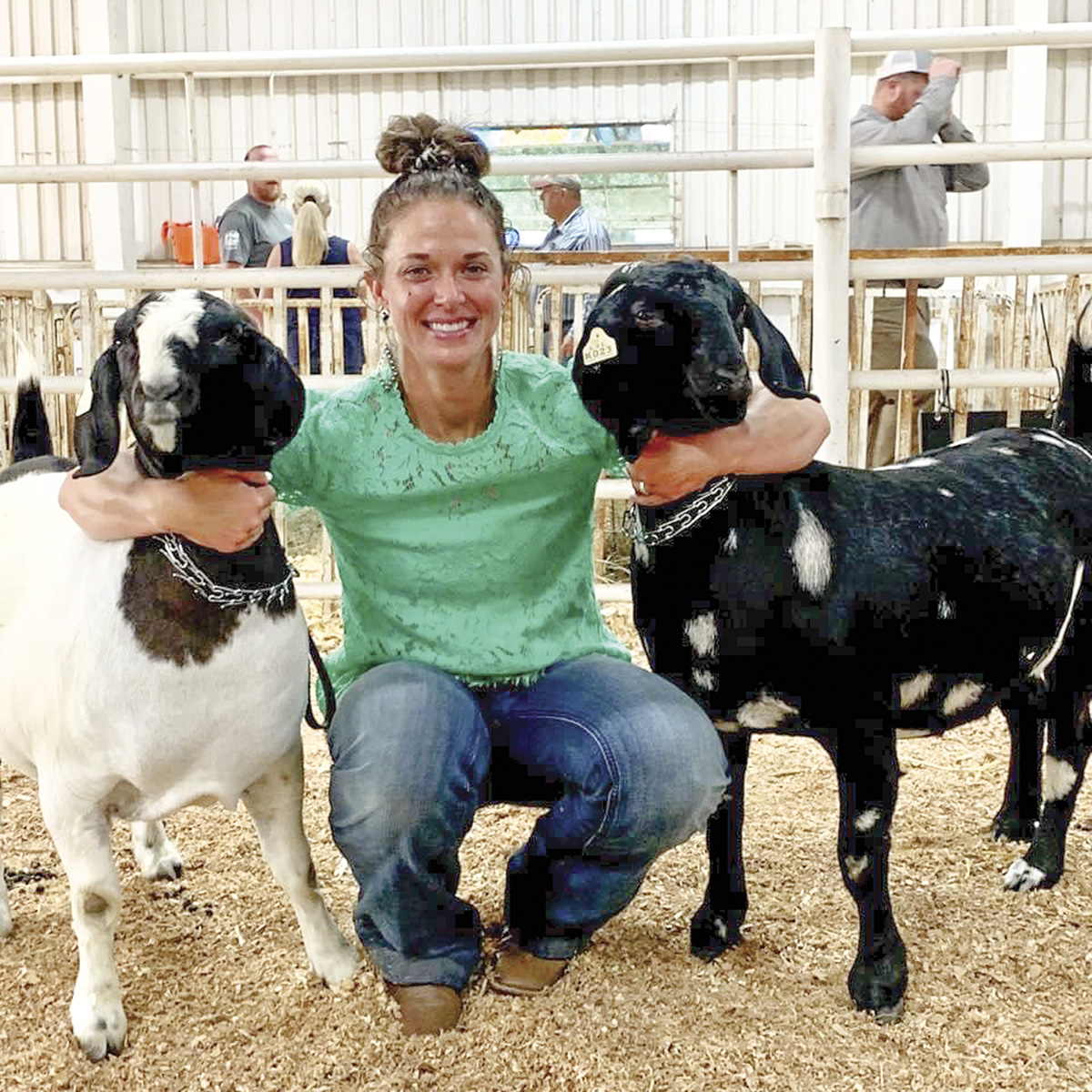Kortney Bahem and her husband, Daniel Lousignont, own and operate L&L Meats LLC – a mobile butchering business in Homedale, Idaho. “The butcher shop was started by Daniel’s father, and we reopened it here in 2014,” Bahem says. She was born and raised in Homedale.
There is a shortage of meat processors around the country, including local custom butchers, so Bahem says she and Daniel are very busy. “All our butchering is mobile; slaughters are done onsite at farms, then we take everything back to our shop to process,” she says.
Bahem and Lousignont do all the kills and processing themselves, without hired help, and are booked through 2022. This is a service that is greatly needed, yet not many people go in this business. “My husband and I are the youngest people I know in this game,” Bahem says. “It’s an aging workforce.”
 Daniel Lousignont processes a beef carcass at L&L Meats in Homedale. Photo courtesy of L&L Meats LLC.
Daniel Lousignont processes a beef carcass at L&L Meats in Homedale. Photo courtesy of L&L Meats LLC.Customers pick up processed meat at the shop and are happy with the finished job. “One reason we are booked so far ahead is: Nearly every time we go out to a customer’s place, they tell us they want to schedule the same number of animals for next year. It’s not that we don’t accept new customers, but the ones we have keep us busy, and we don’t have much space to work in new ones.”
This past October, they took a couple weeks out of their busy schedule to go to Sitkinak Island in Alaska to cut meat for the Alaska Meat Company. “This was the first time we’ve done this, but it may become an annual thing,” Bahem says. “We knew about this meat company, and they came to us earlier to ask if we’d do this, after the new owners acquired the business, but we couldn’t make it work at that time. It was too late in the year when they contacted us, and our business was a lot younger then and we couldn’t afford to be gone that long on that short notice.”
Then the company got in touch with L&L Meats again. “We had several meetings with them through the spring and summer, and then some things happened in October that enabled us to take time off from our business,” Bahem says. She says two of their customers had to cancel. “They’d gotten excited about all the beef they’d planned to sell; they thought they would have 25 head for us to butcher between the two of them in October. Just before our last meeting with the Alaska people, both of those customers told us those cattle don’t exist. That was a game-changer in being able to go,” Bahem says.
It would have been easy to fill those spots and stay busy through October, but since the Alaska group had already asked, it looked like a perfect opportunity for a new adventure. “I enjoy adventure and doing something new, whereas my husband is more business-minded and more reluctant. He felt it had to be worth our time to go up there and things have to be right in our own shop, whereas I’m more ready to just walk away for a while and go,” Bahem says.
“We went up there thinking we’d try it, and if we didn’t like it, we wouldn’t have to do it again. But we both had a great time, so we’ve already set things up to go again this next fall, possibly for a longer duration,” she says.
They were in Alaska 19 days this first trip. “We got weathered in on the island and ended up staying an extra four days. It was a great experience and kind of nice not having to deal with customers and logistics. All we had to do was cut meat. We also got to see the island, though there’s not much to see because it’s uninhabited. It’s just the cow herd, the bunkhouse and the processing facilities.”
This remote island is off the southern end of Kodiak Island, 115 miles south of the town of Kodiak. The meat company is the only ranch on the island, which is grazed as a state lease. The company partners own the cows, which are adapted to this unique environment. The herd goes back to 1937, when the first cattle were brought to Sitkinak Island. They thrive in the lush coastal environment. The island is almost entirely grassland with very few trees and receives more than 70 inches of annual rainfall.
Native grasses provide year-round forage for the semiwild cattle in a stress-free environment. The partners harvest a grass-fed product from cattle that are minimally handled, providing a high-quality product to their meat customers. They pride themselves on raising cattle in a self-sustained remote environment, providing Alaskan people with the highest-quality, local grass-fed beef. The cattle enjoy natural grazing yearlong, never confined for feeding. They are never given vaccines, hormones or chemicals and are not branded. The cattle are harvested with a mobile processing unit and never stressed.
“The company sells whole beef and halves, cut and processed, some ground beef and quarters, and 99 percent of the meat goes to Alaskan customers. Every year, they put a crew together to go harvest and process the meat,” Bahem says.
The three partners are all from Idaho; they grew up together in the Lost River Valley. They heard about L&L Meats’ processing business and, after meeting with them, were persistent in wanting them to come process their Alaskan cattle.
Bahem and Lousignont enjoy helping young people learn about the meat business. “Every spring before school is out, we have half a dozen 4-H groups or FFA chapters come to our shop, and we do processing demos for them. The last few years, we’ve worked with the local FFA chapter; they put on a district FFA meat judging contest in our shop. We’ve hosted and helped with that every spring,” Bahem says.
 Kortney Bahem sold two Boer goats she raised at a Nebraska production sale. Photo courtesy of L&L Meats LLC.
Kortney Bahem sold two Boer goats she raised at a Nebraska production sale. Photo courtesy of L&L Meats LLC. Bahem and Lousignont also raise show goats and now have about 60 Boer goats. “We got our first goats in 2016; we show and raise seedstock to sell in production sales to other goat breeders. The goats have been a lot of fun. They are more hands-on and fragile than cattle, but we really enjoy them.”
Goats have become popular with many people and there is good demand for them, with good prices. “The general population is eating more goat meat today, so there will probably continue to be a good market,” Bahem predics.


.jpg?t=1687979285&width=640)






